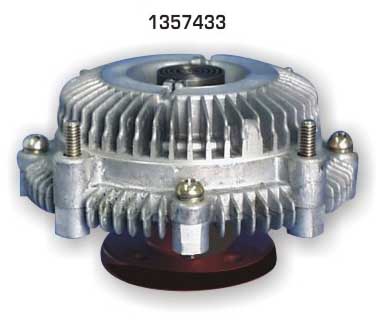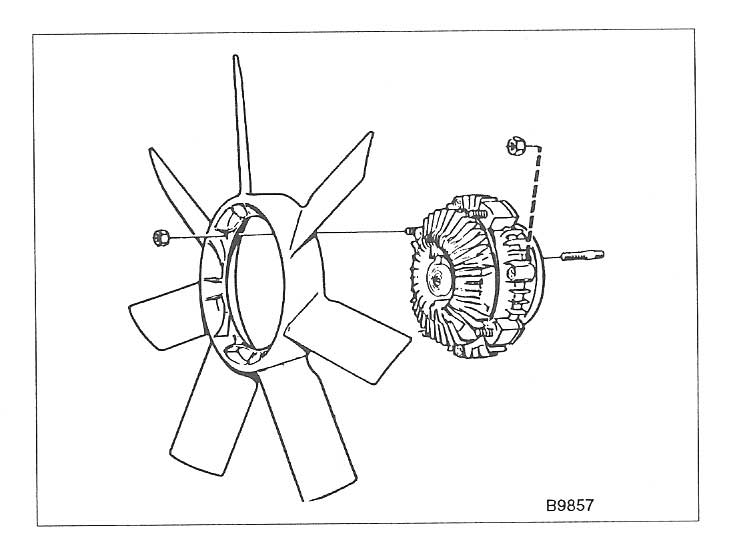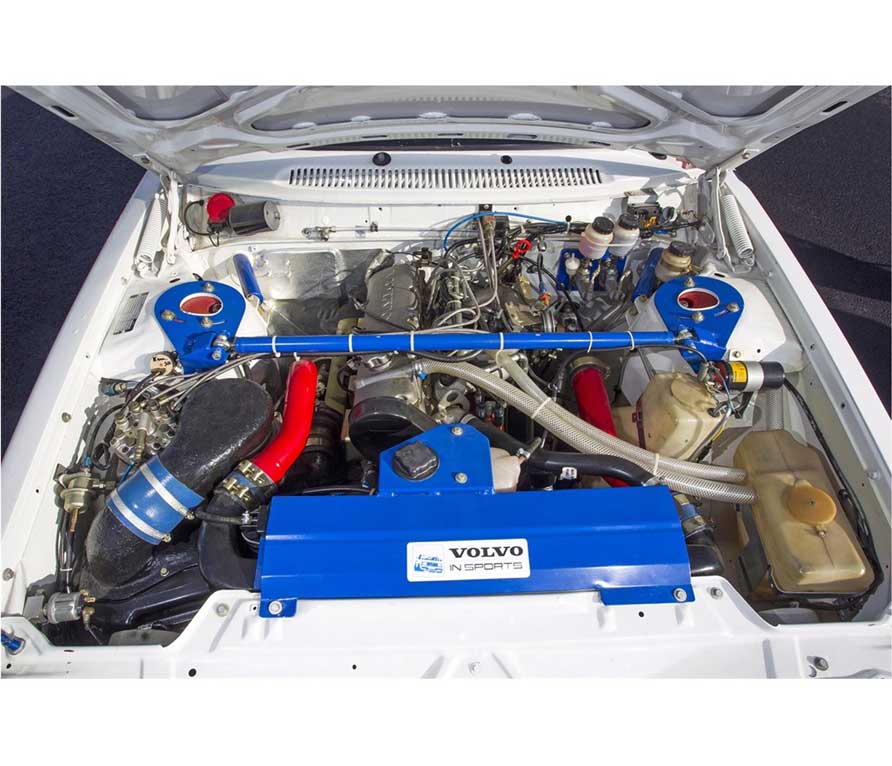2 4 0 T U R B O . C O M
VOLVO TROPICAL
COOLING FAN CLUTCH INFO
|
This item is no
longer offered here for sale.
This page is maintained for its technical interest. |
TROPICAL Version - Heavy Duty
Original Volvo Fan Clutch - Made by Aisin
Original clutch fans for Volvo 240s and 740s were made from 400 mm to 430 mm in diameter.

 Has your original 240 or 740 fan clutch
ever been replaced? They don't last forever.
Chances are, if it's original, it's worn out.
Has your original 240 or 740 fan clutch
ever been replaced? They don't last forever.
Chances are, if it's original, it's worn out.
In
2003 I purchased a pristine '84 242 Turbo. I noticed
elevated coolant temperatures (well above the middle) in the
summer while running the A/C or when driving up long grades on
the freeway. I decided something needed to be
done. I already had a heavy-duty 3-row Nissens radiator
in the car, so why was it running hot? I fitted a 180
degree thermostat (the original was 192 deg.). I think
it helped a little, but it was still running hot when
subjected to moderate loads during warm days, especially if I
turned on the A/C. If I drove up a grade I had to keep a
constant eye on the temp gauge. I considered going to a
primary electric puller fan, but I really wanted to keep the
car original.
I decided it was time to
replace the fan clutch, as I had heard the original ones
didn't pull air as well as when new. As far as I knew,
the fan clutch in my car was an original 1984 part.
I lived in an area of Southern
California that easily got over 100 degrees (F) in the
summer. I thought about buying a new "stock" type fan
clutch. But what if I spent the money and it was
only a small improvement? Or no improvement? It might still run too hot
and all that money would be wasted.
I decided to try a Volvo TROPICAL, HEAVY
DUTY FAN CLUTCH. It's an original Volvo
item, made by Aisin for Volvos in hotter (tropical)
climates. And since Aisin is the original Volvo part
manufacturer, it should last! I was pleasantly surprised by the
result... it pulls noticeably more air when
needed. It probably makes a little more
"whooosh" sound as the engine revs up, but I think that can be
expected, since it is moving more air
through the radiator. I was so impressed by its
performance that I located a supplier and decided to start
offering them here.
Before installing this new fan clutch, my
temperature gauge would often climb above the middle.
Now it consistently stays below 9 o'clock, even on a very hot
day, AND EVEN WITH MY
AIR-CONDITIONER GOING.
Dave's Tropical Fan Clutch Testimonial:
In April 2008, I drove my 242
Turbo to the Davis Volvo Meet in Northern
California. It was pretty warm coming back home
through Bakersfield on Sunday afternoon (90 plus
degrees) and I had the A/C going strong. When I
started up the Grapevine on I-5 (a notorious, long, steep
grade for about 15 miles), I left the A/C on, stayed in
the FAST lane, and kept my speed up in the 70-80 mph range
(boost was consistently up around 7-10 psi for extended
periods of time). Most other 240 Turbos would see
the temp rising steadily all the way to the red in this
situation (mine sure would have when I first bought
it). My temp gauge went up slightly, maybe 10-15
degrees, then stayed put all the way up and over the
grade. I was never more proud of the old
Turbo. My passenger, who also owned two 240 Turbos
and knows well what he should have seen the gauge do,
couldn't believe his eyes.
I'm pretty sure the fan
clutch was responsible for this modern Volvo miracle,
since it's the ONLY thing I had added to the
cooling system (except for a new Nissens 3-row radiator
when the existing one started seeping). But keep
in mind, this car DID already have a Nissens 3-row
radiator when I bought it. It used to run hot with
that. But not any more. Adding the fan
clutch made a noticeable difference in this car for
sure.
-Dave
Customer Comments:
"...the
tropical fan clutch really made a difference on my 760T...."
J.C.M.,
Garland, TX.
"I'm writing to
tell the story of my two 240 wagons ('83 and '86 both
stick shifts). Over the last two years, I
bought two 240 wagons for around $500 each. Needless
to say they both needed a fair amount of TLC to get
them back to top-running condition. Anyway I was
pretty happy with the way they both ran with one
exception -- they ran hot. The '83 was worse
than the '86 but they were both bad. Cold thermostats
didn't really help once the mercury got up there and
we wanted to use the A/C.
"Being
a scientifically minded cat, I thought I'd try an
experiment. On the '83 I installed a refurbished
all-metal three core radiator and one of your tropical
fan clutches. The '86 got the same radiator setup
plus an electric fan conversion as discussed on your
site. Both work pretty well now but there is no
question in my mind that the tropical fan clutch setup
is vastly superior. We drove it to San Diego from
Tucson in 100+ fahrenheit weather a month ago with the
A/C on all the way. The temp gauge didn't even
make it to halfway. The electric fan car works
fine but under stress it still creeps past the mid-line
occasionally. The bottom line is that the tropical
fan clutch is the better solution. My only issue
is that under most circumstances the car hardly gets to
operating temperature. I may have to put a regular
thermostat back in it during the winter months.
"I've
already
sold several of the guys around here on your fan
clutches. Oddly it wasn't well known information
around here; only one of the mechanics who had worked
Volvos in New Mexico had heard of the heavy duty
clutches."
N.S.,
Tucson, AZ
"Tonight I took my
teenage son on a driving lesson. We spent an
hour and a half doing parallel parking. The
ambient temps were 85 degrees F, and the A/C was on.
The temp gauge never went above about 9:30... and in
the past, when I've done a lot of stop and go, the
needle would almost go into the red. The thing
should have melted down. It didn't.
Verdict: The fan clutch works." T.A., Saint Paul, MN
THERMOSTATS:
There are a number of thermostats available for Volvo 240
and 700 models. In most parts of the U.S., your
Volvo will likely have a 92 degree Celcius (197.6 F)
thermostat or an 87 degree Celcius (188.6 F) from the
factory. I think the hotter thermostat was used in
many parts to help reduce emissions. In most places,
the 92C will be way too hot. My preference has been
to switch to the 82C (179.6 F). It seems to permit
good warm ups and the needle sits just below 9
o'clock when fully warm. In southern
California in the summer, the 87C (188.6 F) I tried
usually had the needle just above 9 o'clock. Your
area may be different. And in areas that get extra
cold in the winter, an 82C might promote slower
warm-ups. I don't recommend the 71C thermostat
anywhere, unless you're in Iraq in the summer.
Here
are some Volvo thermostat part numbers:
273459/71:
71C
(159.8 F)
273459/82:
82C
(179.6 F)
273459/87:
87C
(188.6 F)
273307/92:
92C
(197.6 F)
NOTE:
Regarding
testing your old fan clutch and useless internet articles:
I have received a number of emails from people who want
to find a way to positively determine if their old fan clutch is
worn out before they commit to buying another. For
most fan clutches, it's very difficult to measure any function
or efficiency, since fan clutches are pretty
mysterious. A search through the internet doesn't
help much at all, because you will find articles that tell
you, "...if the fan can
be spun by hand... if it makes more than 5 turns after the
engine is off.... etc., then it's worn out." Most of these articles are
crap.
I have also
had some determined customers, who
have installed this new fan clutch and, after reading
some of these misleading articles (or after talking to a
"mechanic friend" who read an article) come to the conclusion
the new tropical clutch must be defective because it spins a
certain way after revving or idling, as mentioned in some
article. What I always tell these people to do is go out
and drive the car and see if it does it's job. This always
results in a change of attitude, because these fan clutches do
work well, regardless of the mysteries behind them.
But if you must know how to
test a fan clutch... their are occasionally some accurate
articles found on the internet on fan clutch function and
which include methods of testing fan clutches the proper way
using a temperature probe and photo-tachometer.
OLDER 240's:
Some 1976-1979 240 models were
equipped with a one-piece clutch/fan unit, identified by a fan
with aluminum blades. These parts are no longer available that I
know of. To upgrade to the later type of fan clutch (such as
this one here), you will need to locate the plastic fan and four
6mm studs with nuts for mounting the clutch to the water pump
flange. IPD has these parts: www.IPDUSA.com.
INSTRUCTIONS
FOR
REPLACING FAN CLUTCH

1. Disconnect the negative (-) battery
cable from the battery.
2. Remove the
screws securing the top of the plastic fan shroud to the radiator.
3. Push or lift
the fan shroud out of the way.
4. Remove the four
(4) mounting nuts holding the fan clutch to the fan pulley. These are
typically 10 mm nuts and will require a 10 mm combination wrench.
5. Separate the
fan from the fan clutch. There are four (4) mounting nuts holding
the fan to the fan clutch. These are
typically 10 mm nuts and
will require a 10 mm socket wrench.
6. Installation is
reverse of removal.
|


















































